2017 TOYOTA MIRAI brake light
[x] Cancel search: brake lightPage 369 of 464
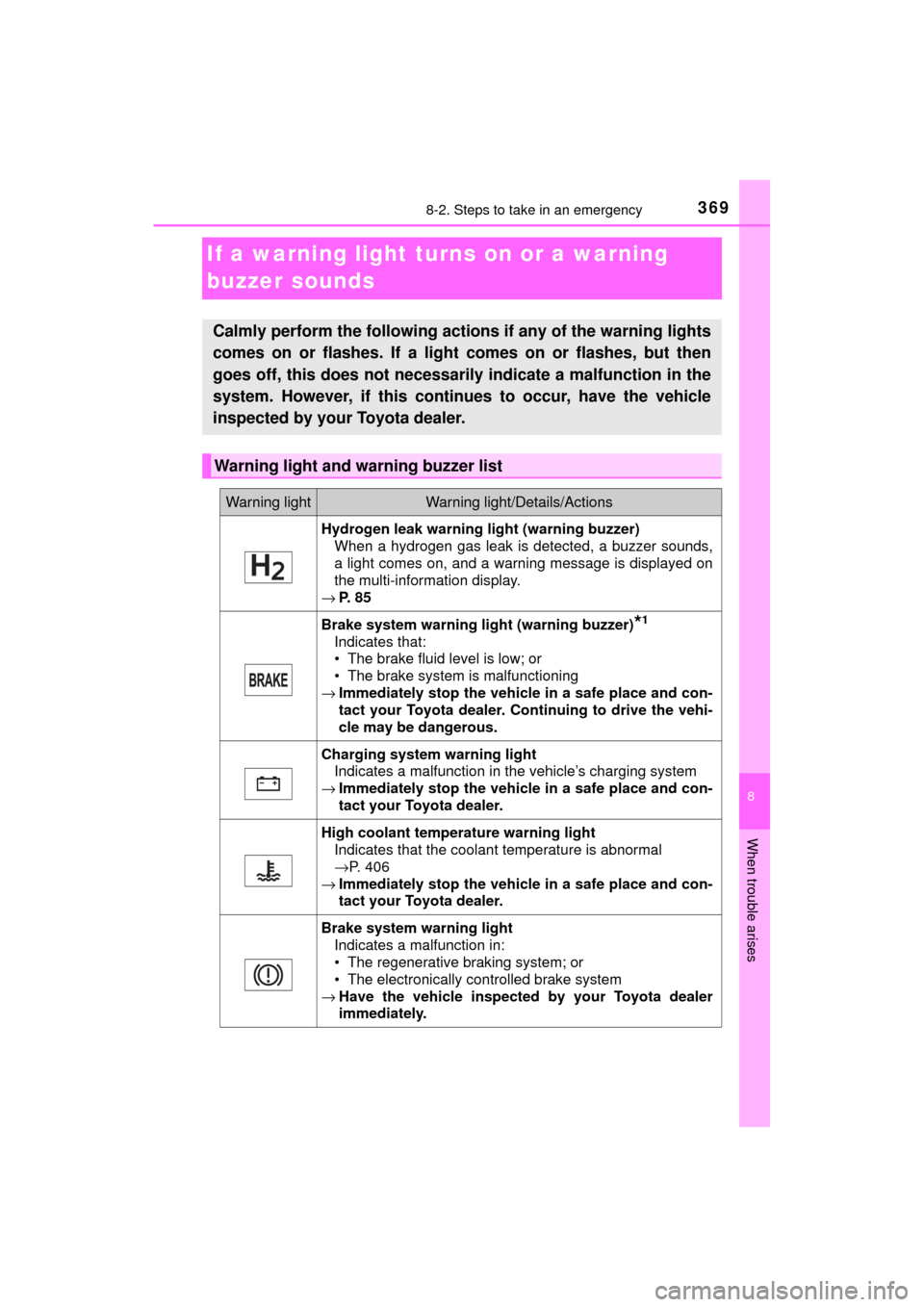
3698-2. Steps to take in an emergency
MIRAI_OM_USA_OM62023U
8
When trouble arises
If a warning light turns on or a warning
buzzer sounds
Calmly perform the following actions if any of the warning lights
comes on or flashes. If a light comes on or flashes, but then
goes off, this does not necessarily indicate a malfunction in the
system. However, if this continues to occur, have the vehicle
inspected by your Toyota dealer.
Warning light and warning buzzer list
Warning lightWarning light/Details/Actions
Hydrogen leak warning light (warning buzzer) When a hydrogen gas leak is detected, a buzzer sounds,
a light comes on, and a warning message is displayed on
the multi-information display.
→ P. 8 5
Brake system warning light (warning buzzer)*1
Indicates that:
• The brake fluid level is low; or
• The brake system is malfunctioning
→ Immediately stop the vehicle in a safe place and con-
tact your Toyota dealer. Continuing to drive the vehi-
cle may be dangerous.
Charging system warning light
Indicates a malfunction in the vehicle’s charging system
→ Immediately stop the vehicle in a safe place and con-
tact your Toyota dealer.
High coolant temperature warning light
Indicates that the coolant temperature is abnormal
→P. 406
→ Immediately stop the vehicle in a safe place and con-
tact your Toyota dealer.
Brake system warning light
Indicates a malfunction in:
• The regenerative braking system; or
• The electronically controlled brake system
→ Have the vehicle inspected by your Toyota dealer
immediately.
Page 370 of 464
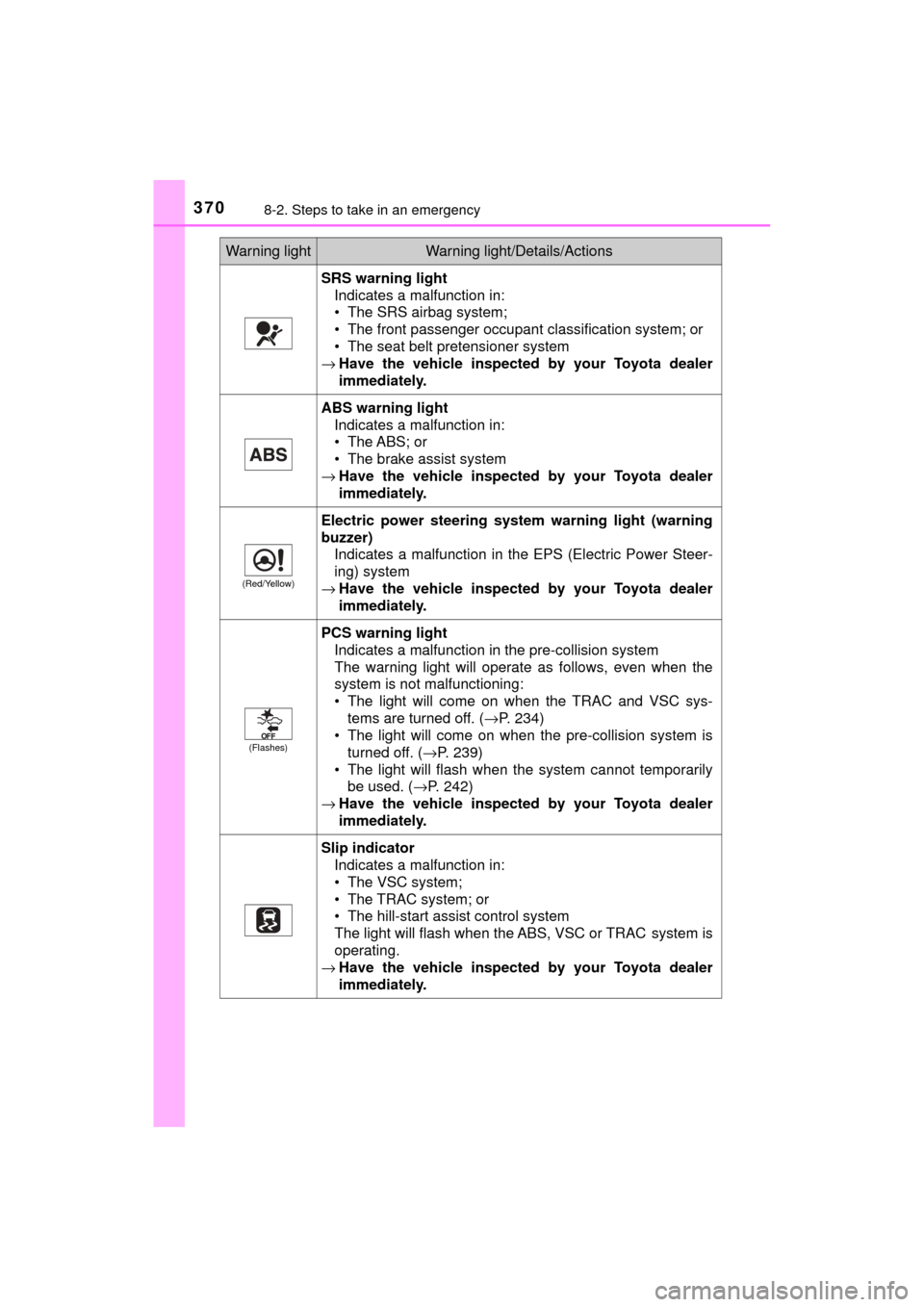
3708-2. Steps to take in an emergency
MIRAI_OM_USA_OM62023U
SRS warning lightIndicates a malfunction in:
• The SRS airbag system;
• The front passenger occupant classification system; or
• The seat belt pretensioner system
→ Have the vehicle inspected by your Toyota dealer
immediately.
ABS warning light
Indicates a malfunction in:
• The ABS; or
• The brake assist system
→ Have the vehicle inspected by your Toyota dealer
immediately.
(Red/Yellow)
Electric power steering system warning light (warning
buzzer)
Indicates a malfunction in the EPS (Electric Power Steer-
ing) system
→ Have the vehicle inspected by your Toyota dealer
immediately.
(Flashes)
PCS warning light
Indicates a malfunction in the pre-collision system
The warning light will operate as follows, even when the
system is not malfunctioning:
• The light will come on when the TRAC and VSC sys-tems are turned off. ( →P. 234)
• The light will come on when the pre-collision system is
turned off. (→P. 239)
• The light will flash when the system cannot temporarily be used. ( →P. 242)
→ Have the vehicle inspected by your Toyota dealer
immediately.
Slip indicator
Indicates a malfunction in:
• The VSC system;
• The TRAC system; or
• The hill-start assist control system
The light will flash when the ABS, VSC or TRAC
system is
operating.
→ Have the vehicle inspected by your Toyota dealer
immediately.
Warning lightWarning light/Details/Actions
Page 371 of 464

3718-2. Steps to take in an emergency
MIRAI_OM_USA_OM62023U
8
When trouble arises
Parking brake warning light (warning buzzer)*2
Parking brake has not been fully released
→ Operate the parking brake once again.
If the light turns off after the parking brake is fully released,
the system is operating normally.
Open door warning light (warning buzzer)*3
Indicates that a door or the trunk is not fully closed
→ Check that all the doors and the trunk are closed.
Low fuel level warning light
Indicates that remaining fuel is approximately 2.4 lb.
(1.1 kg) or less
→ Refuel the vehicle.
Driver’s and front passenger’ s seat belt reminder light
(warning buzzer)
*4
Warns the driver and/or front passenger to fasten their
seat belts
→ Fasten the seat belt.
If the front passenger’s seat is occupied, the front
passenger’s seat belt also needs to be fastened to
make the warning light (warning buzzer) turn off.
Master warning light A buzzer sounds and the warning light comes on and
flashes to indicate that the master warning system has
detected a malfunction.
→ P. 376
Tire pressure warning light
Indicates low tire pressure due to one of the following:
• Flat tire
• Natural causes
• The tire pressure warning system is malfunctioning
→ Immediately stop the vehicle in a safe place.
Handling method ( →P. 373)
Warning lightWarning light/Details/Actions
Page 372 of 464
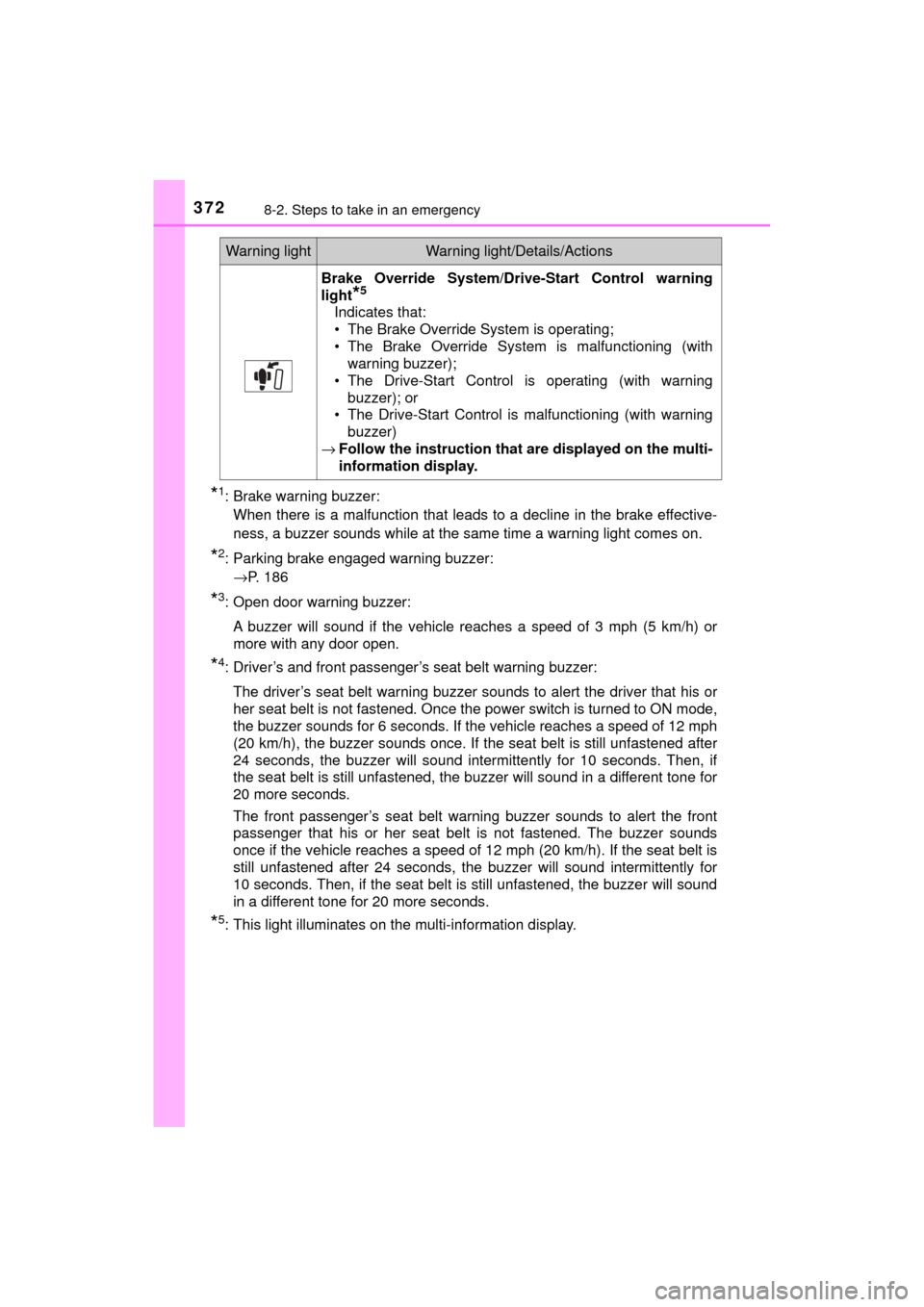
3728-2. Steps to take in an emergency
MIRAI_OM_USA_OM62023U
*1: Brake warning buzzer: When there is a malfunction that leads to a decline in the brake effective-
ness, a buzzer sounds while at the same time a warning light comes on.
*2: Parking brake engaged warning buzzer:→P. 186
*3: Open door warning buzzer:
A buzzer will sound if the vehicle reaches a speed of 3 mph (5 km/h) or
more with any door open.
*4: Driver’s and front passenger’s seat belt warning buzzer:
The driver’s seat belt warning buzzer sounds to alert the driver that his or
her seat belt is not fastened. Once the power switch is turned to ON mode,
the buzzer sounds for 6 seconds. If the vehicle reaches a speed of 12 mph
(20 km/h), the buzzer sounds once. If the seat belt is still unfastened after
24 seconds, the buzzer will sound intermittently for 10 seconds. Then, if
the seat belt is still unfastened, the buzzer will sound in a different tone for
20 more seconds.
The front passenger’s seat belt warning buzzer sounds to alert the front
passenger that his or her seat belt is not fastened. The buzzer sounds
once if the vehicle reaches a speed of 12 mph (20 km/h). If the seat belt is
still unfastened after 24 seconds, the buzzer will sound intermittently for
10 seconds. Then, if the seat belt is still unfastened, the buzzer will sound
in a different tone for 20 more seconds.
*5: This light illuminates on the multi-information display.
Brake Override System/Drive-Start Control warning
light
*5
Indicates that:
• The Brake Override System is operating;
• The Brake Override System is malfunctioning (with warning buzzer);
• The Drive-Start Control is operating (with warning buzzer); or
• The Drive-Start Control is malfunctioning (with warning
buzzer)
→ Follow the instruction that are displayed on the multi-
information display.
Warning lightWarning light/Details/Actions
Page 374 of 464
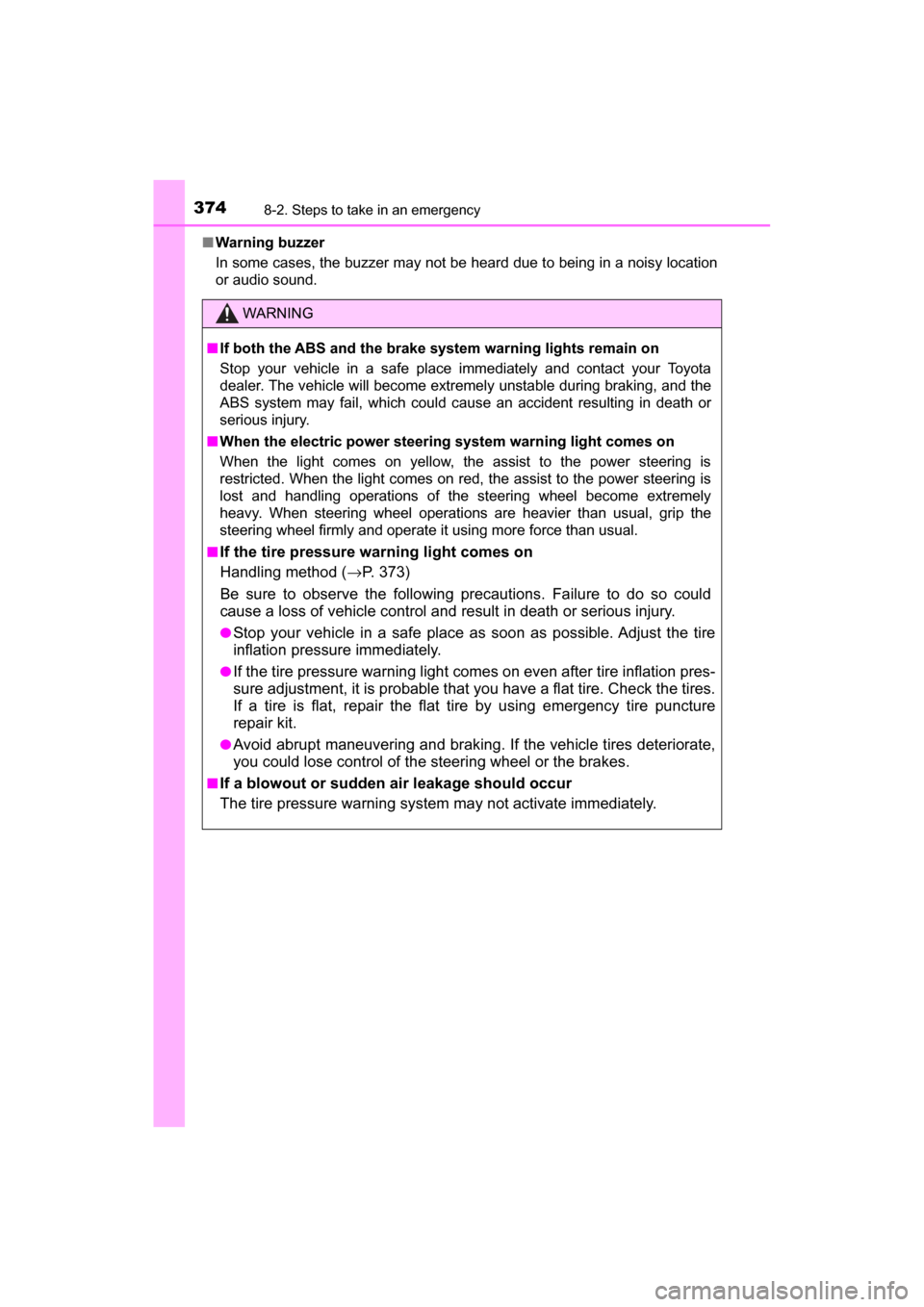
3748-2. Steps to take in an emergency
MIRAI_OM_USA_OM62023U■
Warning buzzer
In some cases, the buzzer may not be heard due to being in a noisy location
or audio sound.
WARNING
■If both the ABS and the brake system warning lights remain on
Stop your vehicle in a safe place immediately and contact your Toyota
dealer. The vehicle will become extremely unstable during braking, and the
ABS system may fail, which could cause an accident resulting in death or
serious injury.
■ When the electric power steering system warning light comes on
When the light comes on yellow, the assist to the power steering is
restricted. When the light comes on red, the assist to the power steering is
lost and handling operations of the steering wheel become extremely
heavy. When steering wheel operations are heavier than usual, grip the
steering wheel firmly and operate it using more force than usual.
■
If the tire pressure warning light comes on
Handling method ( →P. 373)
Be sure to observe the following precautions. Failure to do so could
cause a loss of vehicle control and result in death or serious injury.
●Stop your vehicle in a safe place as soon as possible. Adjust the tire
inflation pressure immediately.
●If the tire pressure warning light co mes on even after tire inflation pres-
sure adjustment, it is probable that you have a flat tire. Check the tires.
If a tire is flat, repair the flat tire by using emergency tire puncture
repair kit.
●Avoid abrupt maneuvering and braking. If the vehicle tires deteriorate,
you could lose control of the steering wheel or the brakes.
■If a blowout or sudden air leakage should occur
The tire pressure warning system may not activate immediately.
Page 397 of 464
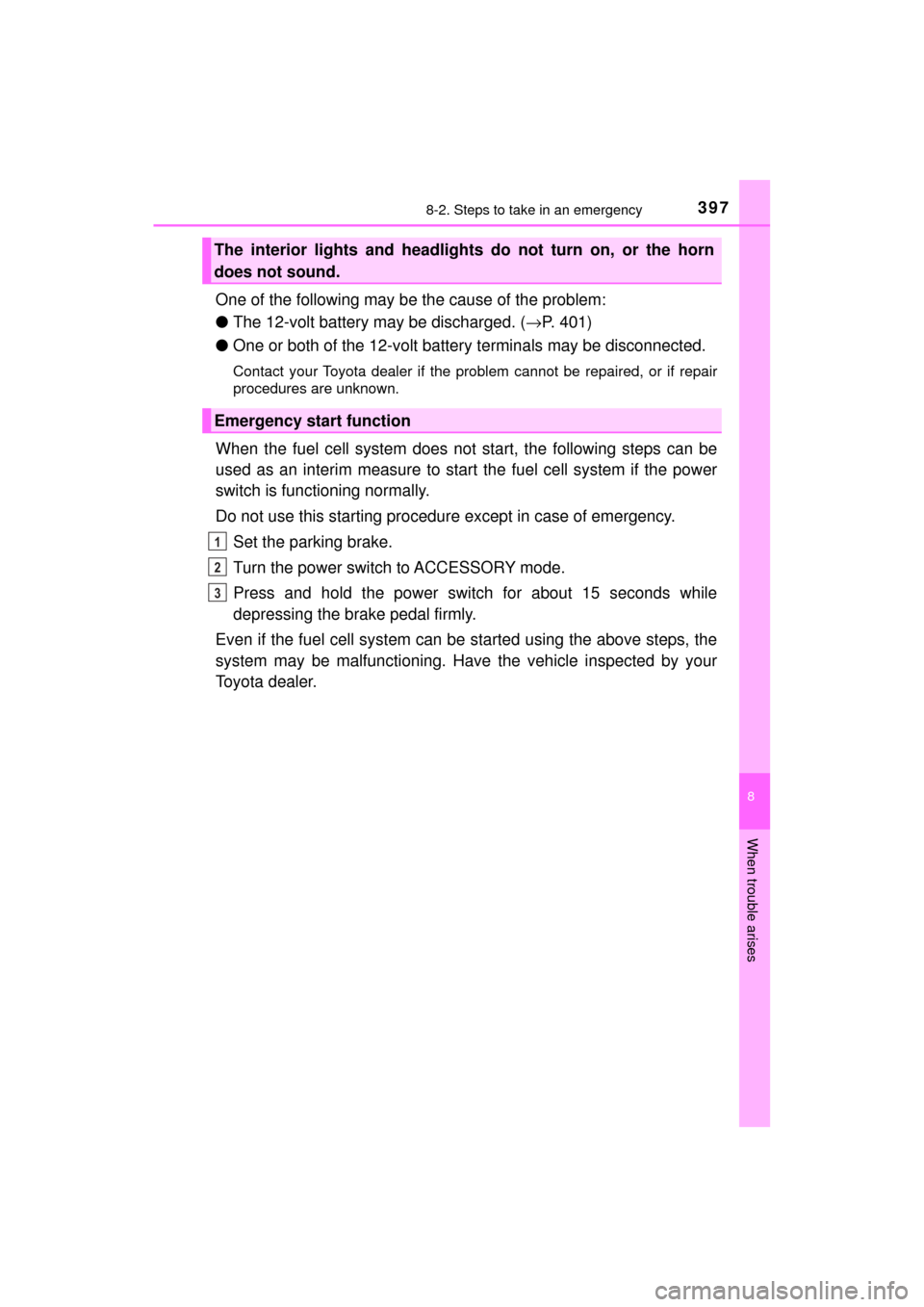
3978-2. Steps to take in an emergency
MIRAI_OM_USA_OM62023U
8
When trouble arises
One of the following may be the cause of the problem:
●The 12-volt battery may be discharged. ( →P. 401)
● One or both of the 12-volt batter y terminals may be disconnected.
Contact your Toyota dealer if the problem cannot be repaired, or if repair
procedures are unknown.
When the fuel cell system does not start, the following steps can be
used as an interim measure to star t the fuel cell system if the power
switch is functioning normally.
Do not use this starting procedure except in case of emergency.
Set the parking brake.
Turn the power switch to ACCESSORY mode.
Press and hold the power switch for about 15 seconds while
depressing the brake pedal firmly.
Even if the fuel cell system can be started using the above steps, the
system may be malfunctioning. Have the vehicle inspected by your
Toyota dealer.
The interior lights and headlight s do not turn on, or the horn
does not sound.
Emergency start function
1
2
3
Page 403 of 464

4038-2. Steps to take in an emergency
MIRAI_OM_USA_OM62023U
8
When trouble arises
Close the exclusive jump starting terminal cover, reinstall the motor
cover and the fuse box cover to its original position.
Once the fuel cell system starts, have the vehicle inspected at your
Toyota dealer as soon as possible.
■ Starting the fuel cell system when the 12-volt battery is discharged
The fuel cell system cannot be started by push-starting.
■ To prevent 12-volt battery discharge
●Turn off the headlights and the audio system while the fuel cell system is off.
● Turn off any unnecessary electrical components when the vehicle is running
at a low speed for an extended period, such as in heavy traffic.
■ Charging the 12-volt battery
The electricity stored in the 12-volt battery will discharge gradually even when
the vehicle is not in use, due to natural discharge and the draining effects of
certain electrical appliances. If the vehicle is left for a long time, the 12-volt
battery may discharge, and the fuel cell system may be unable to start. \
(The
12-volt battery recharges automatically while the fuel cell system is operat-
ing.)
■ When the 12-volt battery is removed or discharged
●In some cases, it may not be possible to unlock the doors using the smart
key system when the 12-volt battery is discharged. Use the wireless remote
control or the mechanical key to lock or unlock the doors.
● The fuel cell system may not start on the first attempt after the 12-volt bat-
tery has recharged but will start normally after the second attempt. This is
not a malfunction.
● The power switch mode is memorized by the vehicle. When the 12-volt bat-
tery is reconnected, the system will return to the mode it was in before the
12-volt battery was discharged. Before disconnecting the 12-volt battery,
turn the power switch off.
If you are unsure what mode the power switch was in before the 12-volt bat-
tery discharged, be especially careful when reconnecting the 12-volt battery.
● If the 12-volt battery is depleted with the shift position in P, it will not be pos-
sible to shift the shift position other than P. In this case, the vehicle cannot
be towed without lifting both front wheels because the front wheels are
locked by the parking lock. ( →P. 363)
● When the 12-volt battery is reconnected, start the fuel cell system, depress
the brake pedal, and confirm that it is possible to shift into each shift posi-
tion.
● Make sure that the key is not inside the vehicle when recharging or replac-
ing the 12-volt battery. The key may be locked in the vehicle if the alarm is
activated. ( →P. 75)
9
Page 420 of 464
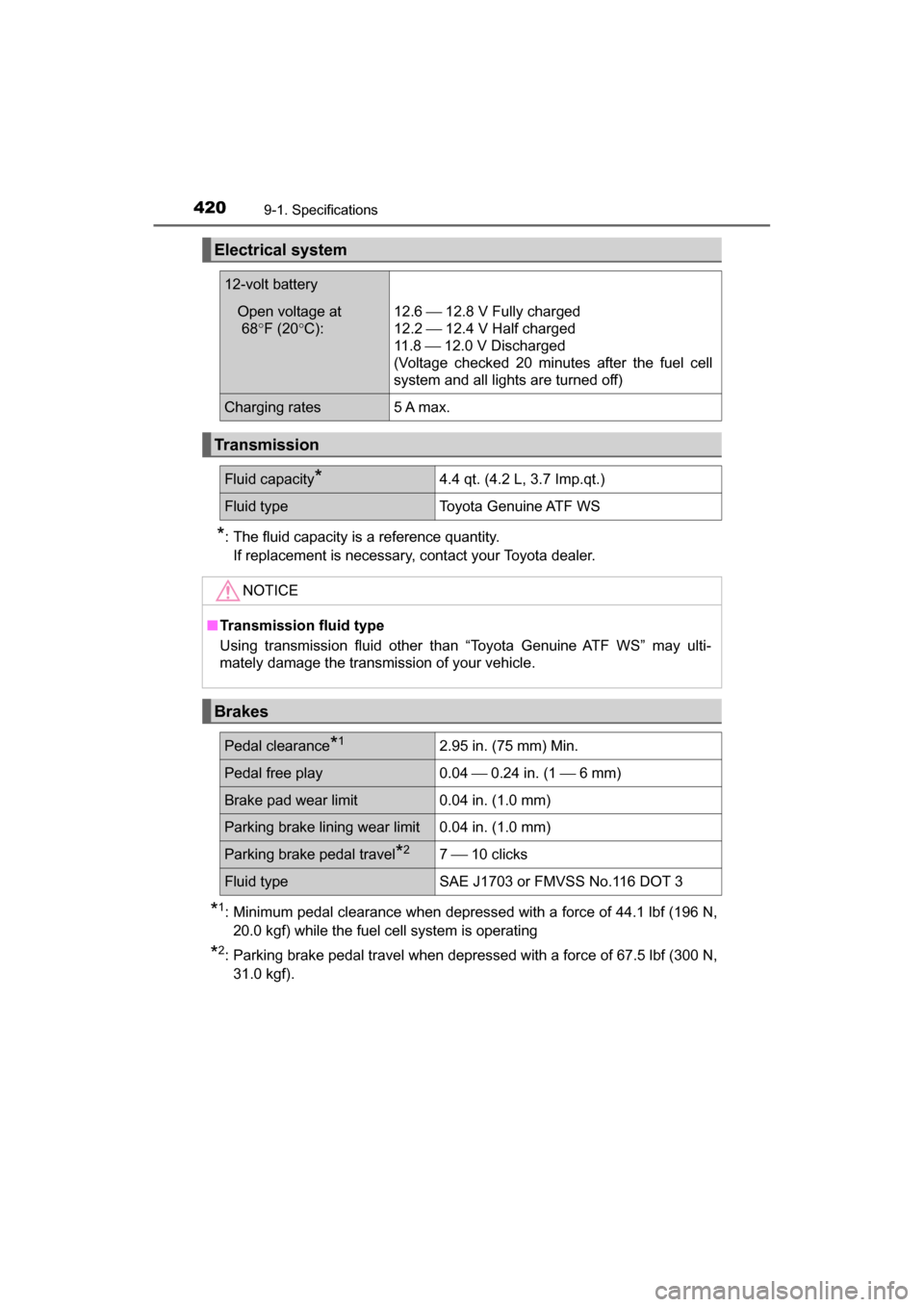
4209-1. Specifications
MIRAI_OM_USA_OM62023U
*: The fluid capacity is a reference quantity. If replacement is necessary, contact your Toyota dealer.
*1: Minimum pedal clearance when depressed with a force of 44.1 lbf (196 N,20.0 kgf) while the fuel cell system is operating
*2: Parking brake pedal travel when depressed with a force of 67.5 lbf (300 N,31.0 kgf).
Electrical system
12-volt battery
Open voltage at
68° F (20 °C):12.6 ⎯ 12.8 V Fully charged
12.2 ⎯ 12.4 V Half charged
11.8 ⎯ 12.0 V Discharged
(Voltage checked 20 minutes after the fuel cell
system and all lights are turned off)
Charging rates5 A max.
Transmission
Fluid capacity*4.4 qt. (4.2 L, 3.7 Imp.qt.)
Fluid type Toyota Genuine ATF WS
NOTICE
■ Transmission fluid type
Using transmission fluid other than “Toyota Genuine ATF WS” may ulti-
mately damage the transmission of your vehicle.
Brakes
Pedal clearance*12.95 in. (75 mm) Min.
Pedal free play 0.04 ⎯ 0.24 in. (1 ⎯ 6 mm)
Brake pad wear limit0.04 in. (1.0 mm)
Parking brake lining wear limit0.04 in. (1.0 mm)
Parking brake pedal travel*27⎯ 10 clicks
Fluid type SAE J1703 or FMVSS No.116 DOT 3